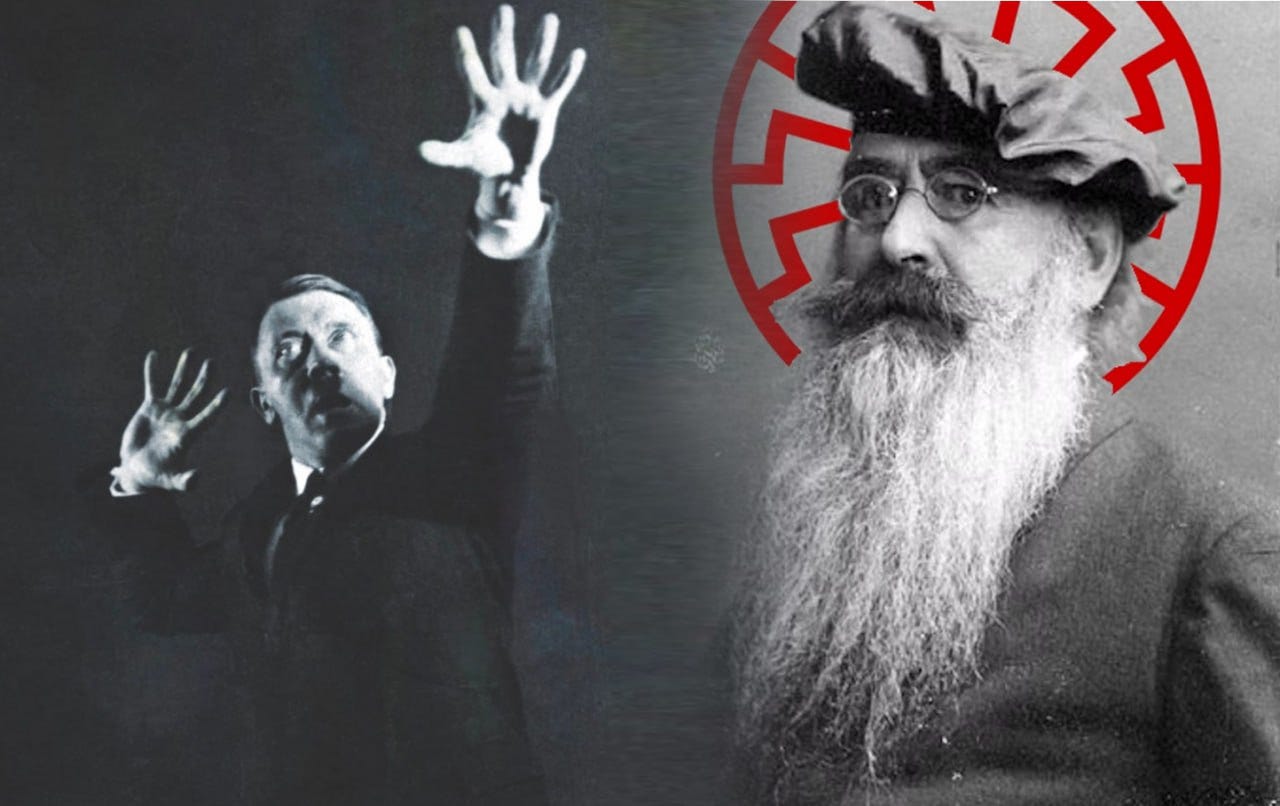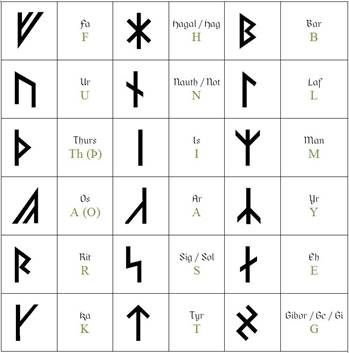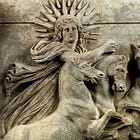Guido von List’s Templar Order Revival – the Armanenschaft (heirs to the Sun-Kings) & an Aryan New Age
From Theosophy to Wotanism: How 20th Century Nordic Mythology was Created in Service to Ario-German Millenarianism Part III

“The continuity of such beliefs through the Third Reich with its eschatological vision of genocide…Only religious beliefs and myth could explain the success of an ideology concerned with special racial and esoteric knowledge and the apocalyptic promise of group salvation in a millenarian apotheosis of the German nation.”
- Nicholas Goodrick-Clarke “The Occult Roots of Nazism: Secret Aryan Cults and their Influence on Nazi Ideology” (1985)
This is Part III of this series, for Part I refer here, for Part II refer here.
In the previous instalment, we had discussed the political situation in the Austro-Hungarian Empire which had resulted in the radicalisation of several groups who began to identify with blood and soil ideology as a reaction to the oppressive laws within Austria-Hungary. One group in particular was the OUN which splintered into the OUN-M and OUN-B, the latter of which was infamously led by Stepan Bandera.
Another radicalised grouping was also beginning to form around Pan-Germanism, to which Guido von List’s Armanist-Ariosophical ideology would later be adopted by German groups such as the Germanenorden (Germanic or Teutonic Order) and the Thule Society. This was to serve as a romanticised history and religion that would in turn justify a German blood and soil outlook which partook more in fantasy than historical reality.
Guido von List was at the core of this religious development and Theosophy was to play a central role (as discussed in Part II of this series). Through the creation myths contained within the Eddas (which we already showed to be heavily influenced by Christian millenarianism in Part I of this series), as well as Blavatsky’s stories of the origin of the universe and the seven root races (which included the Aryan race as the fifth root race), List formed his own esoteric pagan religion called “Wotanism” which also promoted the beginning of a New Age where the Aryan race would be dominant and lead the evolutionary ascent towards the sixth and seventh root race (again using Blavatsky’s theosophical model).
Like the Theosophists, List claimed that he could see hidden knowledge and the true past of his people, which were the Germanic people (i.e. Norse people), through clairvoyance. List had claimed that the reason why there was no historical record left of the great Germanic civilizations was because the Christians completely erased it from the face of the earth in a conspiracy to enslave their people. Thus, the history of the German people and their subjection to the whims of empire was made possible by this Christian conspiracy, according to List. However, rather strangely, despite being quite vitriolic towards the Catholic Church, List would receive support from certain high-ranking members of the Catholic Church as discussed in Part II of this series in his particular endeavour of bringing about his new esoteric pagan religion, Wotanism.
Despite there being no traces left of the glorious Germanic civilizations of the past, List claimed to be able to see this hidden history of the Germanic people through his occult “magical powers” as an Armanist magician, which he inherited as a descendant of a line of priest-kings.
Very much along the lines of Blavatsky’s creative writing, List would create a secret order of elite that were responsible for conveying him messages. It was through this secret order of priest-kings that the history of the Germanic people had been preserved over centuries, awaiting the day of a New Age, where their people would finally be vindicated and reign supreme. This secret order was known as the Armanenschaft.
In fact, during 1916 and 1917 List wrote several articles about what he prophesised to be the approaching national millennium for the German people. He claimed that this would occur with the defeat of the Allies in the First World War and prophesied a Ragnarök millenarianism where the dead warriors of the past would be revived to fight in the final great battle. Needless to say, his prophecy fell quite off the mark. In the early autumn the Habsburg empire began to dissolve and the Austrians were compelled to sue for peace on 3 October 1918. List regarded the catastrophe in a millenarian context - this collapse was necessary as a period of woes before the true salvation of the Ario-Germans (as is the eternal fate of millenarian prophecies -to constantly push back the date of salvation, though near enough that people still believe it will occur within their lifetime). Thus, although his prophecy had not come to pass, this did not stop a belief amongst the Armanist-Arisophists that the day would soon come of an Ario German millenarianism and this continued to be a strong belief up into the Second World War as we will see.
It was through List’s “clairvoyance” that he was able to construct what he claimed to be an Aryan proto-language based off of the Norse runes, which became known under List’s work as the Armanen Futharkh, i.e. the Armanen Runes. It cannot be stressed enough that it is the work of List which has entirely pioneered the field of völkisch rune occultism, as already discussed in Part II of this series.

Through this language that List created through his imaginative deciphering of the runes, something he claimed was only visible to the initiated priest-kings of the Armanenschaft, he created elaborate “histories” of the Germanic people based solely on his imaginative interpretations.
List’s self-ennoblement was clearly an integral part of his Armanist fantasy, since according to List he would not have been bestowed with such magical powers without his elite ancestry. Thus, he would change his birthname Guido Karl Anton List to Guido von List to claim an aristocratic heritage, whose family, he claimed, went back to the Crusades.
In fact, the Crusader Templar Order was to play an integral part in List’s esoteric history of the Armanenschaft. According to List’s magical powers of clairvoyance, he determined that the Templars had not in fact been guilty of worshipping a Baphomet idol but rather it was the gnostic sigil of the Maltese cross, the most sacred sigil of all, as per List.
List claimed that the Maltese cross was the most sacred since it was constructed using the skewed imposition of clockwise and anti-clockwise swastikas.
Thus, List would uphold that it was in fact the Crusader Orders of the Templars and later the Knights of Malta who were part of the Nordic guard of the Armanenschaft.
In this paper, we will discuss the Freemasonic structure of List’s Armanenschaft that would later largely influence, if not be entirely adopted, by the Schutzstaffel (SS) - also stylised with Armanen runes as ᛋᛋ - and the Thule Society who viewed themselves as the continuation of an ancient Ario-German warrior line - the descendants of the Armanist Nordic Crusaders.
List’s Templar Order Revival – the Armanenschaft
The word “Armanenschaft”, which List applied to his ancient hierarchy, ‘can be traced to his spurious adaptation of Teutonic myth related by Tacitus in his Germania. According to the Roman author, the ancient Germans had preserved an account of their origins in traditional songs. These songs celebrated an earth-born god Tuisco and his son Mannus as the founders of their race. To Mannus they assigned three sons, after whom the three constituent tribes of ancient Germany took their names: the coastal tribes were called Ingaevones; those of the interior Hermiones; and the remainder, Istaevones.
Contrary to Tacitus and other classical historians who had attempted to identify these tribes with known appellations, List claimed that these names denoted social estates within the Ario-Germanic nation. He claimed that the Ingaevones, Hermiones and the Istaevones represented the agricultural, the intellectual and the military estates.
It was the intellectual estate, a body of priest-kings, that formed the basis of List’s political fantasy. He germanized the word Hermiones to Armanen, meaning the heirs of the sun-king, while their priesthood was called the Armanenschaft.’[1]
This philosophy is very similar to the sun-worshipping that was observed in Ascona where such notable figures such as Carl Jung had been heavily influenced in the shaping of his ideology amongst many other notable figures.
The reference by List of heirs to the sun-king in his choice of the word Armanen is also interesting in the context of freemasonic-occult symbolism. As already discussed in my paper “The Birth of the Modern Templars, the Origins of the Ancient Scottish Rite and the Roman Sun King Napoleon,” the god Helios had special significance to Julian the Apostate (a self-proclaimed follower of Helios the Sun God) which would later hold special significance to King Louis XIV (self-dubbed the sun-king) and Napoleon (known as the Roman Sun King).
As we will see further on in this series, Hitler would also be influenced by a sun-worshipping religion, List’s Armanen, meaning “heirs to the sun-kings.”
It was under Julian the Apostate that a pagan revival occurred in the form of the Mithraic mysteries as a substitute to Christianity within the Roman Empire, it was under King Louis XIV that a modern Templar Order was revived, and under Napoleon that we saw the take-over of the Scottish Rite in freemasonry within France.
It is also interesting to note here that Germany would see its own revival of a modern Templar Order, as did France under King Louis XIV. In my paper “The Birth of the Modern Templars, the Origins of the Ancient Scottish Rite and the Roman Sun King Napoleon,” this revival of a modern Templar Order in France was discussed:
“…Philip Duke of Orleans, who was the brother of King Louis XIV, the Sun King, continued this secret society of resurrected Templars, after King Louis XIV had so-called banished it. And in order to give this secret society clout as the true continued line of the original Knights Templars, a Jesuit priest – Bonanni, creates a false historical document with a fabricated list of all the Grand Masters of the Knights Templar that had apparently continued the line since the death of Molay. This false document claimed that the Order had continued after the death of the last Grand Master of the Order of the Knights Templar - Jacques de Molay, with Philip Duke of Orleans playing a prominent role within this secret society of the Modern Knights Templar.
Thus, it is interesting that it was during King Louis XIV reign that such an attempt to revive the Order of the Knights Templar occurred under the direct overseeing of his brother Philip Duke of Orleans.”
The case of Germany would not be so different…
Goodrick-Clarke writes:
“Although the idea of chivalric Freemasonry first occurred around 1737 in France, the first Templar rite was introduced in Germany in 1755 by Baron Gotthelf von Hund (1722-76). Calling his order the Rite of Strict Observance, Hund claimed to possess secret Templar documents dating from the time of their suppression, which allegedly proved that his order represented the legal Templar succession. Hund speculated that the Templars had been privy to the secrets of the Temple of Solomon in Jerusalem, which was held to be the origin of the Craft.”[2]
This again implicates the Jesuits directly.
C.W. Heckethorn writes in his “Secret Societies of All Ages”:
“The Grand Orient was established in a mansion formerly belonging to the Jesuits in Paris, and became a revolutionary centre. The share of the Grand Orient, the tool of the Duke de Chartres, took in the events of the French Revolution is a matter of history.
…Catholic ceremonies, unknown in ancient Freemasonry, were introduced from 1735 to 1740, in the Chapter of Clermont, so called in honour of Louis of Bourbon, Prince of Clermont, at the time grand master of the Order in France.
From that time, the influence of the Jesuits on the fraternity made itself more and more felt.
The candidate was no longer received in a lodge, but in the city of Jerusalem; not the ideal Jerusalem, but a clerical Jerusalem, typifying Rome. The meetings were called Capitula Canonicorum, and a monkish language and asceticism prevailed therein. In the statues is seen the hand of James Lainez, the second general of the Jesuits, and the aim at universal empire betrays itself, for at the reception of the sublime knights the last two chapters of the Apocalypse are read to the candidate – a glowing picture of that universal monarchy which the Jesuits hoped to establish.
The sect spread rapidly, for when Baron Hunde came to Paris in 1742, and was received into the highest Jesuit degrees, he found on his return to Germany that those degrees were already established in Saxony and Thuringia, under the government of Marshall, whose labours he undertook to promote.
From the exertions of these two men arose the “Rite of Strict Observance,” which seemed also for a time intended to favour the tragic hopes of the House of Stuart…”
…In 1767, there arose at Vienna a schism of the Strict Observance; the dissentients, who called themselves “Clerks of the Relaxed Observance,” declaring that they alone possessed the secrets of the association, and knew the place where were deposited the splendid treasures of the Templars. They also claimed precedence not only over the rite of Strict Observance, but also over all Masonry. Their promises and instructions revolved around the philosopher’s stone, the government of spirits, and the millennium. To be initiated it was necessary to be a Roman Catholic, and to have passed through all the degrees of the Strict Observance. The members knew only their immediate heads…
Freemasonry had been made the tool and fool of prince – and priest-craft.”[3]
Thus we would have in both the cases of France and Germany an organized revival of the Templar Order under the Sun King Louis XIV as well as in Germany under Baron Hunde, both of which were brought about by a Jesuit initiative.
In 1911, List founded the High Armanen Order (Hoher Armanen-Orden), or HAO, as an inner group of Armanist practitioners within the List Society. As we will see, this revival of the modern Templar Orders in France and Germany is very relevant to List’s construction of the Armanenschaft. List saw the Templar Order as an integral part within this priesthood in service to the sun-kings and he would heavily borrow from Freemasonry and Rosicrucianism in the formation of his HAO with him as its grandmaster…








